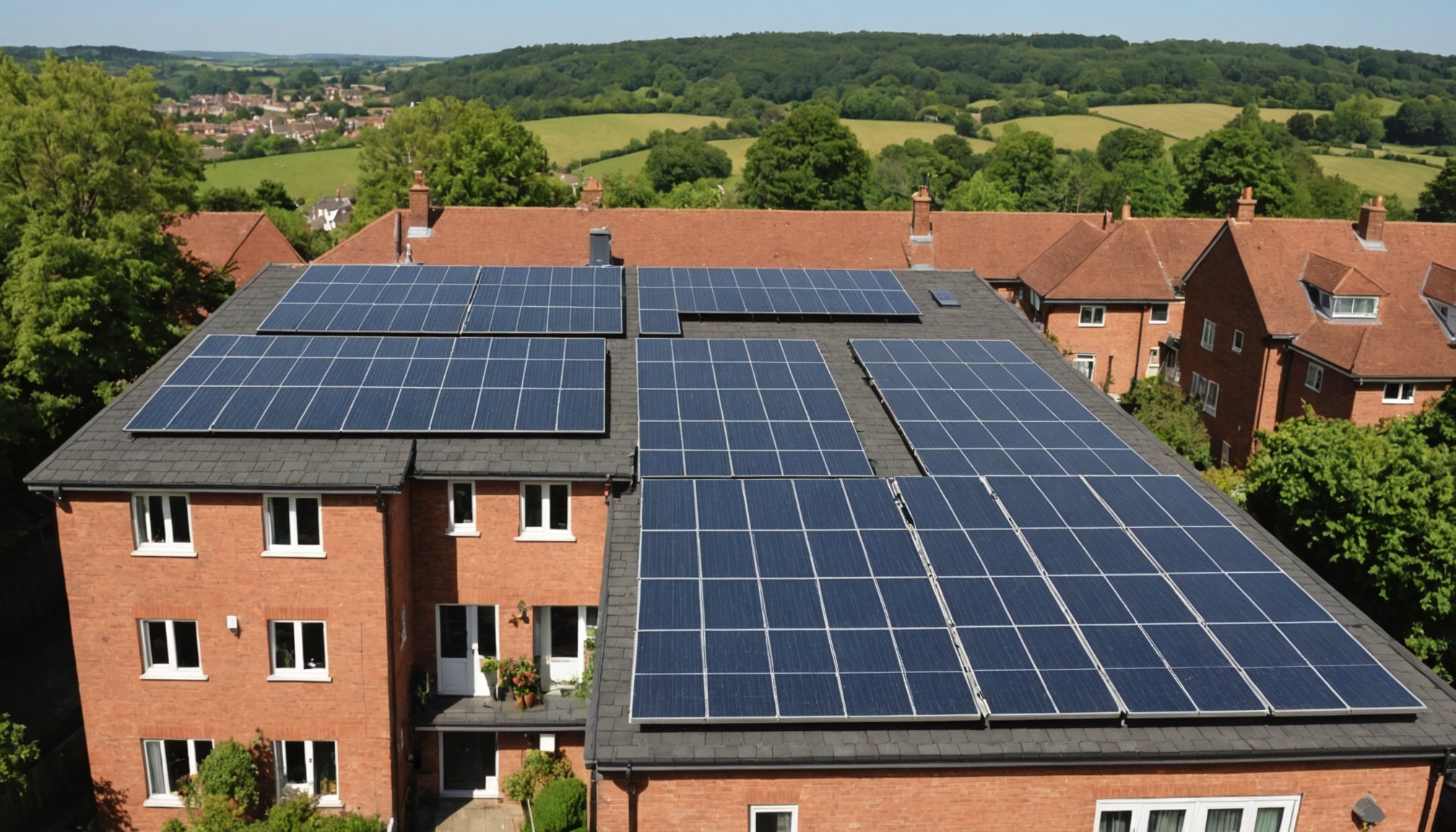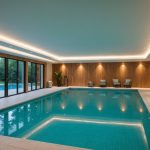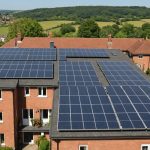Understanding Solar Efficiency for Terraced Roofs
The importance of solar efficiency in residential energy savings cannot be overstated. Optimising solar panel efficiency on terraced roofs offers significant benefits, potentially reducing electricity bills and increasing property value. Unlike traditional roofs, terraced roofs present unique challenges in solar energy production. Their structure often leads to shading from adjacent buildings or elements like chimneys, affecting overall solar panel efficiency.
To effectively harness solar energy on terraced roofs, understanding local climate conditions is crucial. Climate impacts panel effectiveness, where factors like sunlight hours, temperature fluctuations, and seasonal changes play a significant role. In regions with ample sunlight, solar panels may produce more energy, whereas areas with frequent overcast conditions might see reduced efficiency.
A lire aussi : Exploring Optimal Approaches for Retrofitting Double Glazing in York’s Historic Listed Buildings
Solar energy optimisation on terraced roofs involves strategic placement and angling of panels to maximise sunlight capture. Choosing high-efficiency panels that perform better in low-light conditions can be beneficial in less sunny climates. Moreover, regular maintenance checks, such as cleaning panels and ensuring they’re free from debris or shadowing objects, are essential to maintain efficiency.
In essence, while terraced roofs present certain obstacles, by considering their unique characteristics and leveraging an understanding of local climate, homeowners can significantly boost solar panel efficiency and reap the benefits of solar energy.
A lire en complément : Top Energy-Saving Cooking Techniques for Your UK Kitchen: Maximize Efficiency and Minimize Bills
Best Practices for Solar Panel Arrangement
Arranging solar panels for maximum efficiency involves several key considerations. Understanding the optimal layout is crucial in ensuring the best energy output, especially when dealing with terraced roofs. The installation guidelines suggest a few important factors.
Firstly, assessing the tilt angle is essential. It significantly impacts energy capture by affecting how sun rays hit the panels. Ideally, the panels should be tilted at an angle that corresponds closely to the latitude of the location. This ensures that the panels receive the maximum possible sunlight throughout the year, optimizing their performance.
Another crucial factor is the spacing between panels. Adequate spacing prevents the casting of shadows over adjacent panels, which is vital to minimize shading effects. Shadows can significantly reduce the energy harvested by your solar array because shaded portions of panels can underperform compared to fully illuminated sections.
In terraced household settings, consider the multiple levels and structures that could dictate the panel alignment to promote efficient sunlight exposure. This may involve strategic placement, ensuring that elements such as chimneys or other roof structures do not impede on the optimal energy intake for the panels. Proper consideration of these elements during installation will lead to more effective and long-lasting solar energy solutions.
Case Studies from Reading: Successful Solar Installations
Diving into solar installations in Reading, several local examples demonstrate significant energy improvements. In Reading’s terraced homes, effective solar panel arrangements have shown remarkable results. Notably, a local case study reveals homes reducing their energy bills by 40% annually after solar installations. Before installation, these homes were relying mainly on grid electricity, facing substantial energy costs.
Once solar panels were added, the homes achieved considerable energy independence, producing enough to not only cover daytime usage but also storing surplus energy for the evening. Energy outcomes demonstrate a 60% increase in renewable energy consumption for these households, highlighting the effectiveness of well-planned installations.
Lessons learned from these installations include the importance of optimizing panel placement. For instance, positioning on south-facing roofs maximizes sunlight capture throughout the day. Furthermore, collective negotiations by communities in purchasing panels can lead to reduced costs and shared maintenance responsibilities, encouraging wider adoption.
Another significant finding is the positive impact on home value. Properties with solar panels in Reading have been found to appreciate in value due to decreased utility costs and increased energy efficiency. This case study serves as a compelling example that can guide future installations, offering a blueprint for sustainable, cost-effective energy solutions.
Maximizing Sunlight Exposure
Maximizing sunlight exposure is crucial for optimising the efficiency of solar panels. The panel orientation plays a significant role in capturing the maximum amount of sunlight, influenced by the sun’s path across the sky. To determine the optimal orientation, one should analyse the sun’s trajectory throughout the day and across different seasons. The angle and position of panels should be adjusted to align with the most sunlight hours, ensuring they face as directly as possible towards the sun’s path. This maximization of solar gain is foundational to achieving better energy efficiency.
A critical aspect of maximizing sunlight exposure also involves performing a shading analysis. Shading from obstacles like trees or buildings can significantly reduce a panel’s exposure to sunlight. Several tools, including specialised software, are available to predict shading patterns and help mitigate these effects by suggesting adjustments or placements that will minimise shade impact.
Seasonal variations in sunlight availability further emphasise the need for a dynamic strategy. As the sun’s angle changes with seasons, the importance of precise panel orientation grows, requiring periodic adjustments. Understanding and utilising these techniques and tools effectively ensures the best performance of solar panels year-round.
Overcoming Shading Challenges
Addressing shading solutions on terraced roofs is crucial for optimal solar panel performance. Shading can arise from various sources, such as neighbouring buildings, chimneys, and even protruding tree branches. These obstacles significantly affect energy production by casting shadows over the panels, which leads to reduced efficiency.
Innovative solutions have been developed to combat these challenges and improve solar panel output. One effective approach involves the strategic placement of solar panels to avoid shaded areas whenever possible. This method takes into account the sun’s path and the layout of potential obstacles to ensure consistent exposure to sunlight. Another solution is the use of microinverters, which allows each panel to operate independently. This technology ensures that if one panel is shaded, it does not affect the overall system performance.
When comparing different panel layouts, aim to find a configuration that maximises sun exposure during peak hours. Landscape orientation might perform better on certain roofs, while portrait might suit others. By experimenting with various layouts, it is possible to discover the most efficient layout for your specific terraced roof, effectively minimising the adverse effects of shading. These measures help in ensuring that your solar installation operates at its full potential, thus maximizing energy yield.
Comparing Different Layouts
Exploring layout comparisons can illuminate how different strategies influence efficiency. Three primary approaches—traditional, optimized, and innovative—are worth examining due to their performance and efficiency ratings.
Traditional Layout
The traditional layout has been a staple for many; its straightforward design and implementation make it highly accessible. However, its efficiency ratings can vary significantly. This layout often follows a generic structure, potentially leading to wasted spaces and less effective use of resources. In such settings, the challenge is optimising energy flow and space utilisation.
Optimized Layout
By integrating efficiency ratings into their design process, optimised layouts utilise data to enhance performance. These layouts implement strategic panel configurations to streamline operations, ensuring each element of the design serves a clear purpose. Studies suggest that such layouts can lead to better energy consumption and improved productivity, as the design is tailored to specific needs and environments.
Innovative Layout Strategies
Incorporating the latest technologies and ideas, innovative layout strategies push the boundaries of traditional design. These strategies emphasise new panel configurations that maximise efficiency and adaptability. Potential benefits include increased scalability and customised solutions that can adapt to evolving requirements, showcasing the immense possibilities innovation can offer in optimising spaces and energy.
Visualizing Effective Arrangements
Understanding the ideal arrangement of solar panels is greatly enhanced through the use of visual aids. Such resources simplify the complexities involved in crafting an efficient solar panel setup for your home. They effectively communicate how different effective configurations can maximise sunlight exposure and energy efficiency.
One of the most invaluable assets for homeowners is solar layout diagrams. These illustrations depict various orientations and angles, showcasing configurations that have been proven effective based on geographic location and roof structure. They take into account factors such as sun path, shading obstructions, and surface area. By examining these diagrams, homeowners gain a clearer idea of optimal panel placements customised to their specific circumstances.
Numerous tools are available to assist homeowners in visualising potential solar installations. Software solutions often provide interactive features, enabling users to input their home specifications and view dynamic solar layout diagrams in real-time. Such tools not only offer precise predictions but also educate homeowners on the structural and environmental considerations impacting solar panel efficiency. Online platforms may include built-in tutorials and guides to further demystify the visual data.
Conclusively, embracing these visual tools and diagrams empowers homeowners to make informed decisions, ensuring that their solar panel investments yield the highest possible returns.











